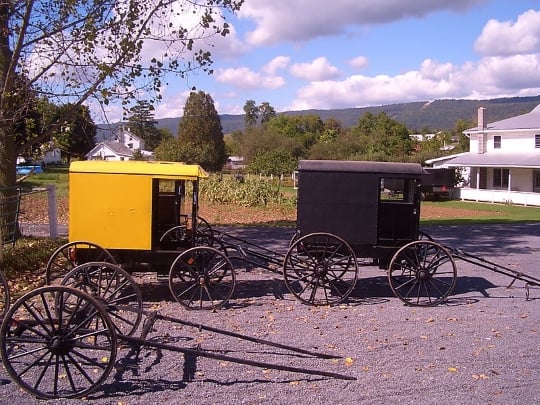Should A Rare Orchid Stop An Amish Farmer From Working His Land?
This is an odd story. A certain endangered orchid happens to grow in only one spot in vast Canada.
That spot happens to be in a little area outside the community of Vita, Manitoba – where a new Amish settlement came to be last year.
One of the settlement’s farmers is now in hot water for disobeying an order not to cultivate land where the rare flower, known as the Western Prairie Fringed Orchid, grows.
From Winnipeg’s CTV News:
In an email to CTV News, a provincial spokesperson said it made a number of efforts to engage landowners about the orchid, providing maps and flagging where it grows.
“However, despite being advised about the presence of the orchids last year and reminded that the land could not be tilled, one landowner proceeded with cultivation. As such, they were charged under the Endangered Species and Ecosystems Act,” said the spokesperson.
“Once it’s gone, it’s gone forever and the legislation is written to prevent that destruction.”
It’s unclear how much of the man’s property is affected – whether the full 160 acres, or if it’s a much smaller area.
The Amishman’s lawyer is arguing that the whole farm is affected, and wants an exemption:
In a letter to Sustainable Development obtained by CTV News, the farmer’s lawyer requests either an exemption to the act or that a prevention order be set aside.
The letter said the order is indefinite in duration and seemingly encompasses the farmer’s entire 160 acres of land.
“This is not a large corporate farm. As is typical in the Amish community farming is done to meet the most basic needs of the family,” the letter said.
On the other hand, government representation says otherwise:
The provincial spokesperson said less than 10 acres on the property in question is affected.
“They have been advised they can cultivate other areas of their property not containing orchids. Some farming practices like haying or grazing areas with orchids can be benign or beneficial and are allowed. The land owners have been advised that grazing would be allowed on the areas containing orchids,” said an emailed statement.
It may be that the random nature of the plants’ locations on the farm creates constant headaches for the farmer.
As Stuartburn Municipality head Lucie Maynard describes it:
“It sounds like the orchid doesn’t grow in a nice square spot. It’s random. Here, there, everywhere. So if he’s always having to go around this and especially with horses and a plow, it’s easier to steer something with wheels or a track, to coordinate horses, that’s got to be more difficult.”
And what if the orchid begins growing in other places on his farm?
Endangered species laws vs. property rights
Laws and regulations protecting endangered plants and animals are ostensibly intended to save species from extinction. But they also mean landowners can lose control over their property.
In the US, there are currently over 1,200 entries on the endangered species list. The restrictions which can result from efforts to save them can interfere to varying degrees with how land is used.
For example, efforts to save a species such as the lesser prairie chicken has affected how the Great Plains area energy industry operates and installs its infrastructure.
On a more individual level, ranchers have balked at participating in conservation efforts to save the chicken, fearing that permanent agreements will prevent them from adapting their land in response to changes in future.
You can see how this would be more of an issue with those who “work the land”, such as farmers and ranchers.
A surprise for everyone?
Amish moved to the area last year, and have been largely welcomed by locals.
But were they aware the land they were purchasing might be affected by protection of the orchid under the Endangered Species and Ecosystems Act?
Apparently even the municipality itself was unaware of the orchid, according to Maynard:
She said the rural municipality had no idea the endangered orchid was on the land.
“They were moving a fairly large family over, about 40 family members, not all of them are here yet, but they are still purchasing some private properties and relocating here,” said Maynard in an interview with CTV News on Monday.
“So they came here to see in the municipality if had some land for sale and we did have some, and we thought it would be great to welcome new people to the area and expand our population.”
It would certainly be depressing to find that land you purchased after moving over a thousand miles is unusable.
Amish people tend not to romanticize nature. The degree to which their practices are environmentally-friendly varies, as David McConnell and Lyn Loveless detail in their book Nature and the Environment in Amish Life.
I can understand how a seemingly ordinary flower might seem like a silly impediment for a man simply wanting to work his land and support his family, as he and his people have done for generations.
Nevertheless, it appears he was warned about the orchid, but chose to proceed anyway.
The Amishman could face a fine or imprisonment as a result.






Buy back the land then.
If the government doesn’t let him use the land as he wants, it shouldn’t have been sold to him. Now, the government should buy it back & reimburse him all costs to leave their flower undisturbed. Make the area a sanctuary.
Other farms?
What about other farms in the area? Have they been blocked from tilling? Most likely this orchid, which I agree is worth saving, is not on just one farm.
Protection of endangered Species
Protection of endangered species is important but so are the rights of the property owners. In these
cases, the property owners should be fairly compensated for financial loses they incur.
Good question. By what I gathered from how the report was given, it sounded like others were informed of this, but that this was the only farmer who chose to go against what they were told.
Amish Farmers vs Endangered Orchid
Just wondering…… If their language was a barrier for understanding the importance of NOT farming certain areas? If the area was was just verbally explained, or Physically marked off?
Some of their practices are far different from the ways of the “Englishers”, or in this case, the Canadians, I assume?!
If you are asking if the English language was a hindrance, Amish people do speak English and many quite well, it’s usually not a problem as far as communication, though in some of the more traditional groups when they are involved in legal matters, interpreters have been used. I don’t gather that is the issue here.
It sounds like they were provided with maps or indications of where the orchid grows, but I don’t think there were any physical markers. It seemed a bit vague going by this report, but perhaps the maps clearly marked which acreage was on and off limits. I’m just speculating here based on how the information was given in the report, so don’t take this as definitive.
Amish Farmers vs Endangered Orchid
I know that some do speak and understand well….others, maybe, not as much.
After reading article again, and comments, I agree that the farm ground with the rare plants should be bought back…condemned, whatever, and the farmer should be compensated for that portion which is not to be farmed….or the whole farm, with any improvements that the farmer has made, such as outbuildings, home etc.
Possibly, he would rather purchase a different farm, without restrictions, and the government should consider that as well.
Government buyback?
Maybe this Amish person should work with the government and let the government either buy the whole farm back, or 5-10 acres where the orchids are growing.
Interesting that he might feel it is a hassle and bother to work around this Orchid with horse-drawn equipment, because it is much the same way people feel driving down the roads 50-60 miles an hour weather barely marked Amish buggy chugging along at 5 miles an hour.
Moving the Orchids
Could it be possible for the Orchids with an ample amount of their own soil, be moved to a greenhouse? I would think that if they had the soil they grow in they would grow and still flourish. Then the government would only have to replace the removed soil with a good quality of replacement soil.
I can’t say anything from the horticultural perspective as to whether that approach would work, but I think the idea behind these laws, and the preservation groups’ efforts, is to keep these species alive in their wild habitats.
this lovely plant would protect from drillers etc.
Become expert on the whole system that includes this plant/ naturalists pay to see such wonders. learn how to propagate and see this as the blessing that it is…the world of complexity is interlinked….
Simple
If the government won’t allow them to work the land, then they should not be forced to pay taxes on the land.
If limited farming is allowed where the orchids grow, then only limited taxes should be charged.
In fact, if it’s such a big deal, then the government should be forced to pay full price to buy the land back and maintain it themselves.
Even the municipality didn’t know the flower was there.
If the flower spreads randomly beyond the original 10 acre section, then the farmer should be left alone….As long as he farms the original 10 acres of orchids as agreed upon.
The reduced taxes or a buyback sounds like a reasonable sharing of the burden. The municipality was not even aware of the orchid situation, and thus did not (was not able to) inform the farmer when they sold him the land (you can see in the video report that the municipality CAO Lucie Maynard speaks strongly on behalf of the farmer).
Endangered species
It occurred to me while reading this story that this man could become an ‘orchid farmer’ and bring it back from near instinction. If he was interested in doing this maybe the government could give him permission to collect seeds (or bulbs-I don’t know anything about orchids) so he could grow more. I was also thinking maybe the government did know about the flowers and couldn’t sell the land because of the restrictions so they saw an opportunity to make some money from unsuspecting people from out of the area. I would just rope off the area around each plant and plow on. My grandfather did that around the ground-nesting birds in his fields. We always walked and looked for the nests before plowing gardens and bailing hay. He only cut hay twice during the season because he knew the mating and nesting habits of the ground nesting birds. If he bailed hay three times a year then by the time it was grown tall enough to cut again it would have been the same week the eggs should be hatching. You learn these things when you grow up farming -how to live together with God’s creation. I asked him when I was about ten years old why all farmer didn’t do what he did. His answer was simply “ Because they’re greedy” . This was in the early 1970s. Smart for an old farmer with a 7th grade education!
Endangered species -- thank you for this perspective
Walk the land before mowing it, yes. Whether it’s birds’ nests, woodchuck burrows, rabbit ditto… Carry sticks with you to mark the DON’T MOW HERE spots. So commonsensical, so kind.
Endangered species
I also read one of the links- the one about the prairie chickens out west. It doesn’t mention him but guess who was one of the first celebrities to be involved with animal activism- Michael Nesmith (of the Monkees). Just google ‘Save the Texas Prairie Chicken ‘. Sorry Erik- and now back to Amish America. I have a strange mix of childhood memories.
No problem it’s all on topic:) The prairie chicken is an unusual but beautiful-looking bird. I think how sympathetic/attractive the species is, ultimately factors into how successfully activists can rally support for it. It seems it’d be easier to gather support for a prairie chicken, than say something called a “blood-sucking slimy prairie slug” 🙂
Preservation measures
Personally, I think the environmental agency should “lease with equitable compensation” the 10 acres of land for 100 years with him, & his heirs so long as it’s in the family, as caretakers for the said plot of land. Should he sell it, then the agreement must be upheld by the new owners.
This way, he can use the land for pasture/hay etc but not till it, and the flower has some EPA protection.
As for the current issue & to answer your question, I think he should be fined if he was given legal documents saying he was forbidden to turn the soil over.
If it was just words from someones mouth, I understand him wilfully plowing. Don’t tell me what I can and can’t do with my land. And if the previous owners knew about this stipulation and didn’t declare it, they should pay a fine too.
Seriously?
As a genetic environmentalist from the heartland, and who absolutely loves and is connected to the land, this is the stupidest thing I think I’ve ever read. Has anyone considered that perhaps mother nature WANTS this orchid to go extinct? The environment evolves. New things come into formation and old things go extinct, and should go extinct. That’s the way the earth works.
Conservation is important, but if you’ve got an endangered plant you want protected, then the govt needed to have declared that piece of land a national sanctuary BEFORE they sold it. You can’t sell land to someone then tell him he can’t till it. Good grief! If this was the USA, the govt would be outta luck, and the only choice they’d have is to eminent domain the land at a substantial cost to the govt.